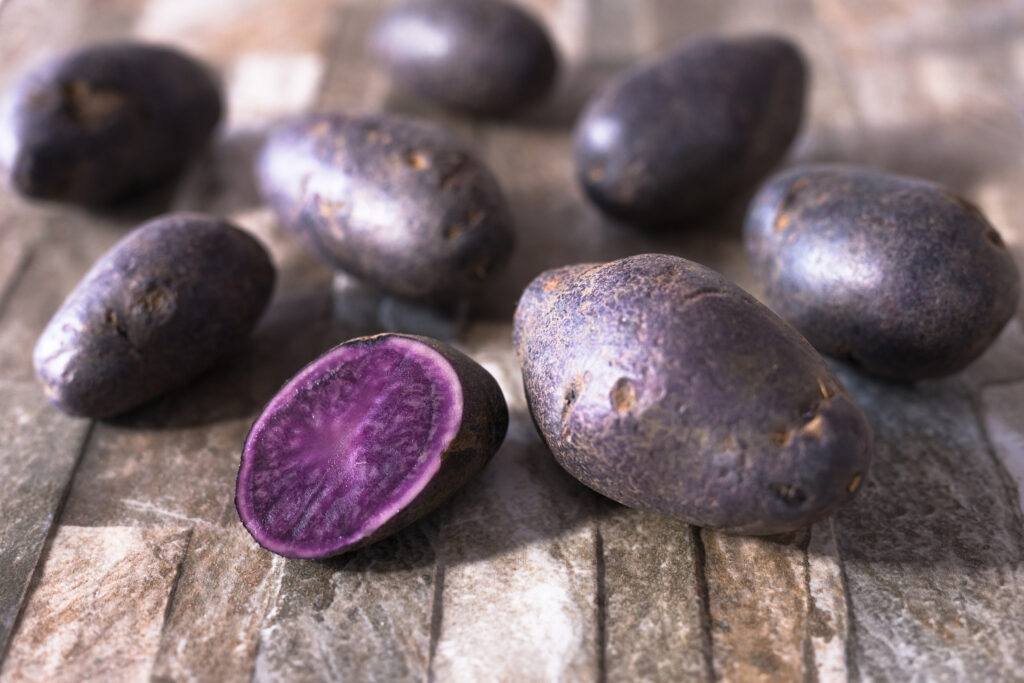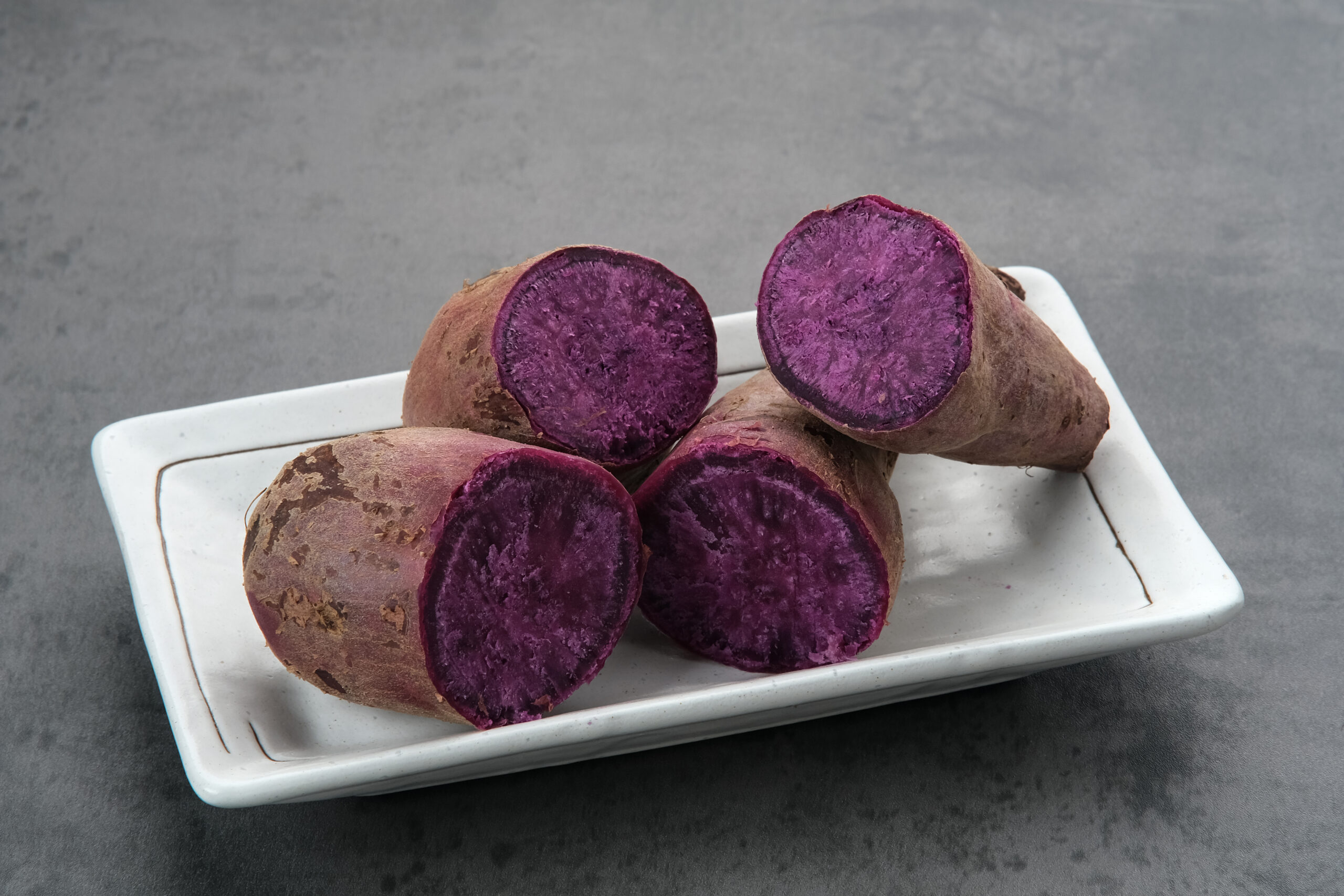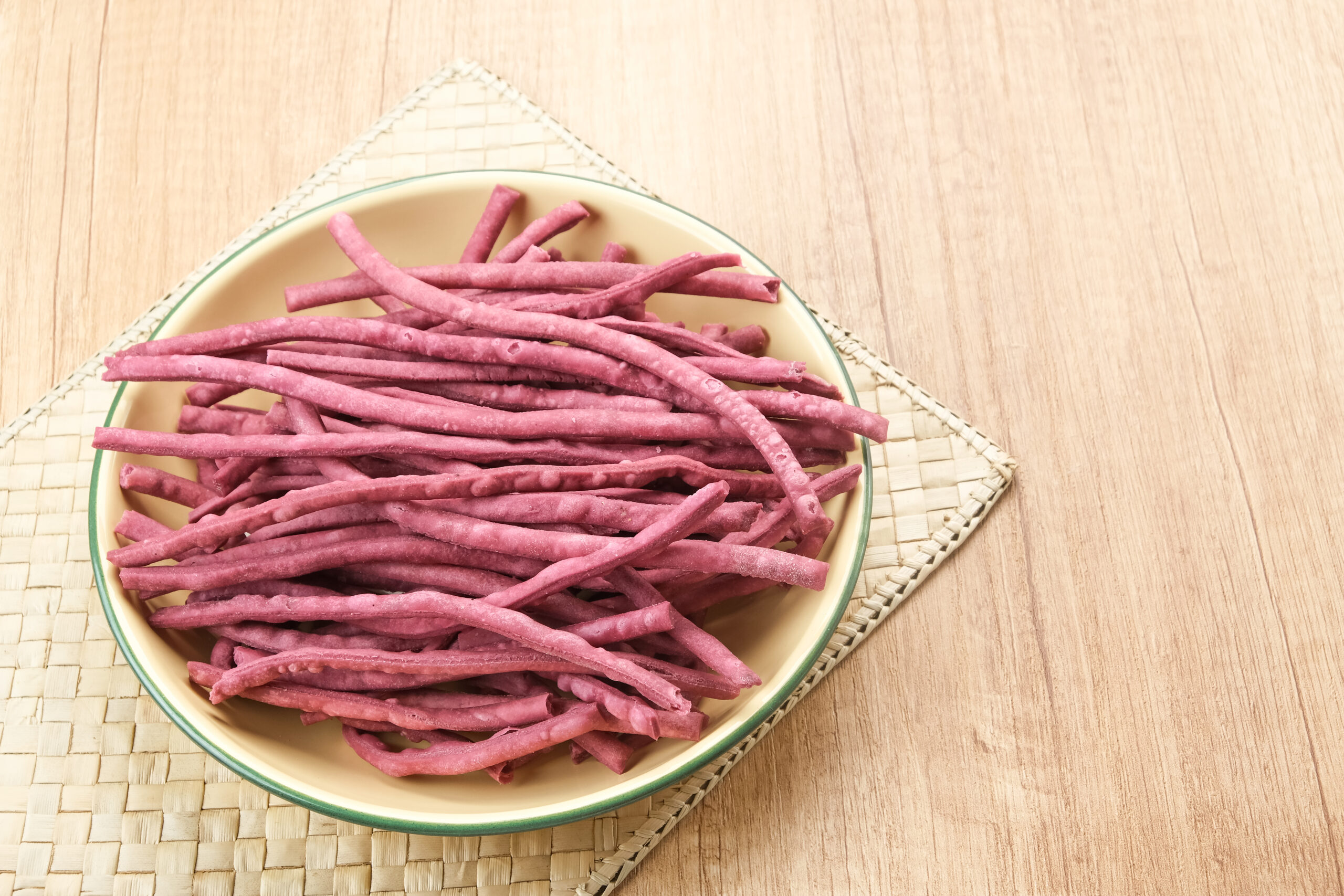Exploring How Okinawans Eat Purple Sweet Potatoes
Okinawa, famed as a ‘Blue Zone’ for its long-living residents, attributes much of its dietary success to the purple sweet potato, known locally as Beni Imo. A standout for its vivid hue and significant nutritional value, the Beni Imo is a staple in the traditional Okinawan diet and is central to understanding how Okinawans eat for health and longevity.”
This revised introduction clearly incorporates the keyphrase “How do Okinawans eat purple sweet potatoes?” It sets the topic from the outset and conveys the importance of Beni Imo in the local diet.
The Diet of Longevity
Okinawans traditionally consume a diet rich in vegetables, legumes, and, notably, the purple sweet potato. This diet forms a cornerstone of their health, providing low calories but high nutrition. Studies have highlighted that the typical Okinawan diet, packed with these purple powerhouses, may include them in up to 70% of their daily meals, showcasing their dietary importance .
Beni Imo: A Nutritional Overview
Beni Imo is celebrated for its nutritional benefits, being low in calories yet high in fiber, vitamins, and antioxidants. Its deep purple hue comes from anthocyanins, potent antioxidants known for their health benefits. This tuber is not only a staple in the local cuisine but is also integral in maintaining the health and longevity of Okinawa’s residents .
These sweet potatoes are versatile in cooking, often steamed, baked, or mashed, and are a key ingredient in many traditional Okinawan dishes. They provide a sweet, slightly nutty flavor that enhances both savory and sweet dishes, making them a beloved ingredient across generations.
By incorporating these practices and ingredients, such as the Beni Imo, into daily life, Okinawans continue to enjoy a diet that supports long and healthy living. This approach offers valuable insights into the benefits of diet on longevity and well-being.
Historical Significance of Purple Sweet Potatoes in Okinawa

The introduction of purple sweet potatoes to Okinawa marks a pivotal moment in the island’s culinary history. Spanish explorers originally brought these vibrant tubers from the Aztec Empire to Asia in the 1400s. By the early 1600s, they had made their way to Okinawa, brought by Japanese officials trading with China .
Adoption and Adaptation
Okinawa, with its unique climate and cultural connections, proved ideal for cultivating Beni Imo. Unlike rice, which struggles in the storm-prone environment, purple sweet potatoes thrived. Their successful cultivation led to widespread adoption across the island, fundamentally altering the local diet .
Impact on Longevity and Health
The robust health and impressive longevity of Okinawans are often attributed to their diet, with purple sweet potatoes playing a crucial role. These potatoes are not only nutritious but also integral in the traditional dietary practices that support health into old age .
Rich in antioxidants and vitamins, Beni Imo contributes to a diet that combats inflammation and supports heart health. Their consistent consumption over generations illustrates their enduring impact on Okinawan culture and well-being .
This historical adoption and the continued prominence of purple sweet potatoes in Okinawa highlight their significance. Not just a staple food, they are a cultural icon, deeply embedded in the traditions and health of the island’s people.
Nutritional Profile of Purple Sweet Potatoes

Purple sweet potatoes, particularly the variety known as Beni Imo in Okinawa, are highly regarded for their nutritional value. These tubers are not only a staple in the Okinawan diet but also stand out among other sweet potatoes due to their unique health benefits.
Nutritional Benefits
Beni Imo is low in calories yet high in fiber, which helps in digestion and prolongs feelings of fullness. Each serving packs a high dose of vitamins, including a remarkable amount of vitamin A, which supports eye health and immunity. The potatoes are also rich in antioxidants, particularly anthocyanins, which give them their purple color and are known for their anti-inflammatory properties .
Comparison to Other Sweet Potatoes
While all sweet potatoes are nutritious, the purple varieties like Beni Imo contain higher levels of antioxidants compared to their orange and yellow counterparts. These antioxidants are crucial for combating oxidative stress and reducing the risk of chronic diseases such as heart disease and cancer .
Versus Other Staple Foods in Okinawa
Compared to other staple foods in Okinawa, such as rice or regular potatoes, purple sweet potatoes offer a lower glycemic index, which is beneficial for blood sugar control. They also surpass these staples in vitamin and mineral content, particularly in vitamins C and E, which are vital for overall health maintenance and disease prevention .
The remarkable nutritional profile of Beni Imo not only underscores their importance in the Okinawan diet but also highlights why they are integral to the longevity and health of the island’s residents. Their widespread use in various dishes reflects their versatility and enduring nutritional value.
Culinary Uses of Purple Sweet Potatoes

Okinawan purple sweet potatoes, or Beni Imo, are celebrated for their versatility in the kitchen. These tubers play a central role in both traditional and contemporary Okinawan dishes, adapting beautifully across various flavors and textures.
Common Culinary Preparations
- Steamed – This method preserves their sweetness and nutrients, resulting in tender, easy-to-mash potatoes .
- Baked – Baking enhances their natural sugars, adding richness to the dish .
- Mashed – Often mixed with coconut milk or spices, this preparation is creamy and flavorful .
Traditional Recipes and Modern Adaptations
Traditionally, Beni Imo appears in pies, tarts, tempura, and even ice creams. These dishes showcase the potato’s flexibility in both sweet and savory recipes .
In modern cuisine, these sweet potatoes find new roles in smoothies, cakes, and health bars. These adaptations cater to a global audience looking for tasty, health-conscious options .
Role in Desserts and Other Sweet Dishes
Beni Imo is a dessert favorite due to its sweetness and color. It stars in traditional Okinawan tarts, blended into a paste and baked in pastry crusts .
Through both traditional uses and modern adaptations, Beni Imo remains a staple in Okinawan cuisine. It is celebrated not just for its flavor but also for its health benefits.
Cultural Impact of Purple Sweet Potatoes in Okinawa
Purple sweet potatoes, or Beni Imo, are integral to Okinawa’s culture. They influence local traditions, festivals, and the economy.
Connection to Local Traditions and Festivals
Beni Imo symbolizes prosperity and health, aligning with its nutritional benefits. It plays a central role in local festivals, celebrated in dishes and decorations . Annual festivals highlight Beni Imo, with traditional recipes and cooking methods on display .
Impact on Local Economy and Agriculture
Beni Imo supports Okinawa’s agriculture and economy as a staple crop. It is one of the island’s main agricultural products . The popularity of these potatoes also boosts tourism, benefiting restaurants and local businesses .
This deep cultural connection helps sustain traditional practices and drives the local economy, affirming Beni Imo’s place in Okinawan identity and prosperity.
Modern Changes and Dietary Shifts in Okinawa
Recent decades have seen significant shifts in the dietary habits of Okinawa, largely due to Western influences.
Western Influence on Diet
The traditional Okinawan diet, rich in vegetables and low in calories, is changing. Younger generations are now embracing more Western foods like meat, refined sugars, and processed goods . This shift has introduced higher calorie foods that are less nutrient-dense, contrasting sharply with traditional choices like the nutrient-rich Beni Imo .
Dietary Trends Among Young Okinawans
Today’s younger Okinawans often prefer fast food and convenience items over traditional dishes. This trend is partly driven by globalized food culture and the pace of modern life, which emphasizes quick and easy meal options . As a result, traditional foods like purple sweet potatoes are consumed less frequently among the youth, impacting their overall health and dietary quality .
These modern dietary changes pose challenges to the health legacy of the Okinawan people, known historically for their longevity and vitality. The community now faces increasing health issues, such as obesity and related diseases, which were once rare in this Blue Zone .
Sustainability and Agriculture: The Role of Purple Sweet Potatoes in Okinawa
Sustainable Farming Practices
Discuss the traditional farming methods used in Okinawa, which include crop rotation and the use of organic fertilizers. These practices help maintain soil fertility and reduce the dependency on chemical inputs, fostering a healthier environment.
Water Conservation Efforts
Detail how the cultivation of Beni Imo is adapted to Okinawa’s climatic conditions, focusing on their low water requirements. This adaptation not only ensures the crop’s survival during dry spells but also conserves water resources, crucial in sustainable agriculture.
Economic and Environmental Impacts
Examine how focusing on native crops like Beni Imo benefits the local economy by reducing costs associated with imports and chemical fertilizers. Highlight how these practices also minimize environmental impacts, enhancing food security and opening new markets such as eco-tourism and health-conscious consumers abroad.
By adding these subheadings, the section will be easier to read and more engaging, with clear transitions from one topic to another while maintaining a coherent narrative flow.
The Future of Purple Sweet Potatoes in Okinawa
As we consider the role of purple sweet potatoes in Okinawa’s past and present, it’s equally important to look ahead at their future prospects within the region.
Adapting to Global Tastes and Trends
With the global rise in demand for health foods, Okinawa’s Beni Imo is well-positioned to gain international acclaim. Future sections of the article could explore how farmers and food producers are adapting to this trend, potentially expanding their cultivation methods and exploring new market opportunities.
Preserving Traditions in the Face of Change
Another angle worth examining is the effort to preserve the consumption of Beni Imo among younger generations. Initiatives could include educational programs about the health benefits of traditional foods, or fusion recipes that combine modern flavors with this time-honored ingredient.
Research and Development
Ongoing research into the health benefits of anthocyanins found in purple sweet potatoes could unlock even more uses for Beni Imo. Investigating how Okinawa is investing in such research can provide insight into the future of this crop and its place in the fields of nutrition and medicine.
FAQs on Okinawan Purple Sweet Potatoes
How Often Do Okinawans Eat Purple Sweet Potatoes?
Traditionally, Okinawans ate purple sweet potatoes daily, making them a core part of their meals. This practice is more common among older generations. Recently, younger Okinawans have started to consume them less often, influenced by Western dietary preferences .
What Are the Best Ways to Cook Them to Preserve Nutrients?
The best methods to preserve the nutrients in purple sweet potatoes are steaming and baking. Steaming preserves antioxidants and vitamins without loss in cooking water. Baking at moderate temperatures enhances their natural flavors while keeping nutrient loss to a minimum .
Can Purple Sweet Potatoes Be Grown Outside of Okinawa?
Yes, it is possible to grow purple sweet potatoes outside of Okinawa. They need warm, well-drained soil and a climate similar to that of other sweet potato varieties. Gardeners and farmers around the world, including in the United States, successfully grow these tubers for their unique health benefits and vibrant color .
These answers provide a clear view of how integral purple sweet potatoes are to Okinawan culture, their nutritional preservation during cooking, and their potential for growth in diverse climates.
Conclusion: Embracing the Legacy of Okinawan Purple Sweet Potatoes
The purple sweet potato, or Beni Imo, stands as a vibrant emblem of Okinawa’s rich cultural heritage and a key element of its renowned longevity diet. These tubers have traditionally nourished generations, providing a wealth of vitamins, antioxidants, and health benefits that promote longevity and well-being.
However, as dietary preferences evolve, influenced by Western habits, the consumption among younger Okinawans has declined. Nonetheless, the cultural importance of Beni Imo continues to shine. These potatoes not only feature in local celebrations but also play a significant role in the agricultural economy, bridging the past and present.
Moreover, the enduring significance of Beni Imo offers a blueprint for a healthier future. They remain celebrated in traditional festivals and are pivotal to Okinawa’s agricultural output. Furthermore, by integrating traditional and innovative culinary uses, both Okinawans and the global community can continue to enjoy the benefits of this extraordinary food.
In essence, the purple sweet potato is not merely a staple; it is a legacy of health and culture that extends far beyond Okinawa’s borders. Looking ahead, it is crucial to keep these culinary traditions alive and continue incorporating Beni Imo into our diets. This practice will harness their proven benefits for future generations, ensuring the legacy of Beni Imo continues to enrich lives globally.

